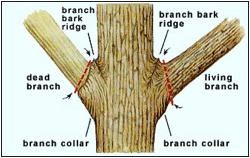The dogwood borer (Synanthedon scitula) is one of the most serious pests of flowering dogwood in Connecticut. Very young trees are frequently killed and older ones are left reduced in vitality and with dead and dying branches. Other plants attacked by this insect include flowering cherry, apple, mountain ash, willow and oak.
Borer-infested trees begin to show swollen, knotty, calloused or gall-like areas on the trunk, just at or immediately below the ground surface or between the ground surface and the branches above. Injuries also occur at the union of the trunk and branches or smaller twigs and branches. Young dogwoods are attacked mostly at the crown.
Life History
The adult dogwood borers are clear-winged moths which begin emerging in late May and may continue to do so until September. They reach their greatest abundance during late June and July. The moths mate and the females lay their eggs on bark, usually near an injury. The eggs hatch and the larvae wander about until they find an opening in the bark, since they cannot chew through uninjured bark. Upon finding an opening, they tunnel into the cambium of the older bark. They are not known to feed in sapwood. Borers in various stages of development can be found at the edge of bark wounds throughout the year. The larvae overwinter in the tree and usually pupate there before emerging the following spring.
Control Measures
It is important to maintain the best possible health and vigor of dogwoods and other trees impacted by this borer beginning with proper site selection and proper planting. In addition fertilizing, pruning and by watering during dry seasons helps to maintain healthy trees.
Maintaining a mulch layer around the plant to aid in keeping the soil cool and moist should help in keeping the plant healthy.
Avoid wounding the trunks and branches. Lawn mower and line trimmer injuries afford excellent places for borers to enter.
Prune at the proper time, do not leave stubs, and prune just outside the branch collar (picture below). No pruning compound or sealer is needed.

A fine wire can be inserted into the entry hole and pushed up the feeding channel to kill the larva.
Trunk applications of registered insecticides before the larvae move into the tree are effective. Once the larvae are in the tree control is extremely difficult. The spray should be applied about four times at monthly intervals starting in mid-May. Contact your local Cooperative Extension center for chemical and management options. Or visit the on-line guides of Cornell University and Penn State. This information may not apply to your state.
Originally written by: Milton G. Savos, Extension Entomologist Emeritus, University of Connecticut
Revised by: Edmond L. Marrotte, Consumer Horticulturist, Department of Plant Science
Updated by: Mary Concklin, IPM, University of Connecticut. 2011
This information was developed for conditions in the Northeast. Use in other geographical areas may be inappropriate.
The information in this document is for educational purposes only. The recommendations contained are based on the best available knowledge at the time of publication. Any reference to commercial products, trade or brand names is for information only, and no endorsement or approval is intended. The Cooperative Extension System does not guarantee or warrant the standard of any product referenced or imply approval of the product to the exclusion of others which also may be available. The University of Connecticut, Cooperative Extension System, College of Agriculture and Natural Resources is an equal opportunity program provider and employer.